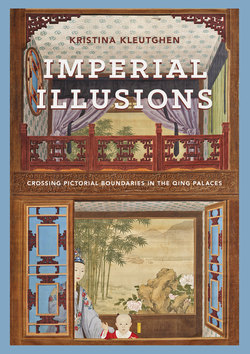Читать книгу Imperial Illusions - Kristina Kleutghen - Страница 59
На сайте Литреса книга снята с продажи.
ОглавлениеThe painting begins just above the cornice level of the church beneath the windows and extends onto the flat ceiling beginning directly above them, taking advantage of the sunlight streaming in through the glass to illuminate the divine space pictured on the ceiling. The illusion that the flat ceiling is a lofty vault open to the heavens is only legible from one position in the church, marked with a golden disc set in the floor of the nave. From this position, the painting unifies the church architecture with the heavens and creates a miraculous vision for the viewer through the theatrical, illusionistic expansion of the church’s limited vertical space into a divinely radiant and infinite celestial realm populated with angels and cherubs. Elaborate gilding, sculpted figural decoration, and numerous columns enhance the fictive white stone architecture, which continues from the real architecture below. Illustrating the Jesuits’ global mission to spread the Catholic faith as the universal church, allegories of the four continents of Asia, Africa, America, and Europe painted between the real church windows are not lifeless white stone sculptures, but spring vividly to life in full color and dynamic movement. Perpetually ascending skyward, the center of the fictive ceiling is entirely open, enabling male and female angels to convey a few particular Jesuits heavenward on rosy clouds. Seemingly the mortal highest up in the firmament, the radiant figure of St. Ignatius of Loyola, founder of the Jesuit order, is personally welcomed into heaven by Christ, who bears the cross of his Crucifixion lightly over his left shoulder while reaching toward St. Ignatius with his right hand. Christ is positioned at the vanishing point of the painting, which is rendered distant through the hazy pastel colors of atmospheric perspective, suggesting a swirling vortex of clouds, rather than the much brighter tones used for the sky and the figures within the architectural confines. The painting resolves at the end of the ceiling farthest away from the viewer in a dark coffered dome with a windowed oculus, which became Pozzo’s trademark feature and was repeated in several Jesuit churches across Europe. Pozzo illustrated the method he used to create this complicated quadratura and transfer the draft to the ceiling in his popular printed treatise Perspectiva pictorum et architectorum (1693, 1698). This treatise not only spread knowledge of the painting and was an important demonstration of Jesuit devotion, but also was held in the Jesuit library in Beijing and later played an important role in at least one court official’s understanding of illusionistic painting.83
By the late seventeenth century, quadratura had also spread to France, where Gherardini (not a Jesuit) was painting for Philip Julian Mancini, the Duke de Nevers (1641–1707). In the late 1690s Joachim Bouvet, S.J. (1656–1730), one of the five French Jesuit mathematicians whom Louis XIV (r. 1643–1715) sent as the “King’s Mathematicians” to the Kangxi court in 1685 and one of only two who served Kangxi directly, convinced Gherardini to join the royal-sponsored French Jesuit mission to Beijing.84 Giovanni Gherardini’s specialized training in quadratura thus brought this most illusionistically deceptive form of perspectival painting forms to Beijing. Gherardini spent the next five years painting for the Kangxi court and training court artists, as well as painting quadratura inside the French Jesuit North Church (Beitang); otherwise almost nothing is known about his
